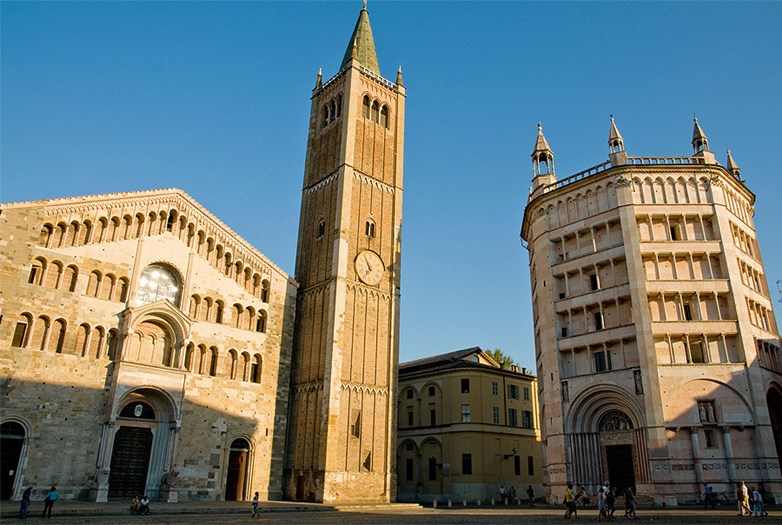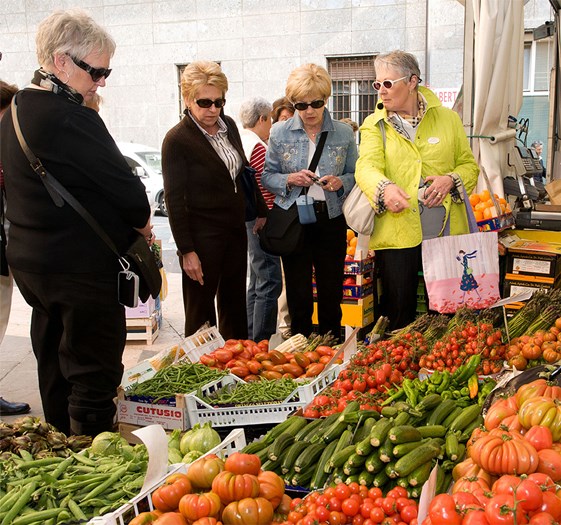PARMA - At first, I think I’ve misunderstood Roberto Bassi when he says, “Cooking can save your life. Really, it can,” insists the culinary manager and chef at Parma’s Academia Barilla.
“It can help you internally, say, if you’re feeling sad, you can cook pasticcino and that’s beautiful. If you need a job and you can cook in a kitchen, then you can work and live.”
And for a sure-fire way to find friends? You must have skills in the kitchen, he says in English tinged with most lyrical Italian accent.
In fact, Bassi so strongly believes in the power of cooking that he’s thrilled that his older daughter, Valentina, who’s just finished law school (which would be a dream come true for many parents) is now taking pastry courses. It’s what he hopes his younger daughter, Alice, will also do once she’s finished studying film.
“She can do something with cinema, but first, try learning how to make bread and pasta plates; that is much better,” says Bassi.

Above: Parma is one of Italy's most historic cities.
We’re chatting during my tour of Parma, which includes a stop at the Barilla factory, where we have a day of cooking classes at the Academia Barilla (led by Bassi himself), olive-oil tastings and a visit to a nearby cheesemakers’ facility, where they produce the famous parmigiano reggiano.
Bassi, like everyone I meet in Parma, is kind and congenial, with an obvious love of food.
“I was born under a pasta line,” jokes Bassi of his 25 years with the family-owned Barilla company.
While his responsibilities have included just about every aspect of the company’s operations — from research and development to consulting with clients — his work now focuses largely on event management and primarily on pasta.
“Pasta is a good example of the Italian philosophy,” he says. “It’s quick, charming, and it’s economical if you need it to be or it can be elegant.”

Above: Homes in Parma are decorated in bright colours.
For example, “add truffle or lobster (to pasta), or you can have good results with just peas and fava beans,” he says.
But the most important ingredient, he says, is passion.
“When you cook dishes with few ingredients, you really need passion as you need to know the raw materials, know the cooking technique, the design and the history,” he says.
“I really like to taste the pasta, to be able to taste the grains,” he explains, noting that cacio e pepe (cheese and pepper) is one of his go-to ways of enjoying it. Most North Americans, you see, drown pastas in too much sauce or with too many ingredients, Bassi says.
So, who better to ask than Bassi on places in Parma to eat.
“Start at Le Greppia,” says Bassi. “It’s very traditional. I think you should start with traditional and then move on to innovation. To really know a country, a city and the people and enter into their mentality, the traditional food is the most important thing to start with.”
As for what to order at Le Greppia?

Above: Parma's markets are full of fresh vegetables.
“Talk to Maurizio, the owner,” recommends Bassi, “and tell him you want to taste Parma’s flavour.”
After Le Greppia, Bassi recommends moving on to more modern cuisine at Parizzi.
You can’t go to Parma and not indulge in parmigiano reggiano and prosciutto di Parma, both foods the region is renowned for. Academia Barilla, in addition to cooking classes, also arranges culinary tours so ask about including one to Caseificio La Traversetolese to learn the ins and outs of making parmigiano reggiano from cheesemaker Antonio Martini (and get a taste of his new healthier, omega-3-enriched parmesan).
“You’ll also want to have a plate of tortelli di erbette while in Parma,” says Bassi, naming this as the classic pasta dish of the city. It’s made of ricotta, erbette (a leafy green similar to spinach), parmigiano reggiano and nutmeg tossed with butter and sage.
But Parma isn’t just about food. Like every Italian city, Parma’s boutiques along Strada della Republica and Strada Cavour are well worth exploring.
When you need to give your feet a break, grab an espresso at a cafe in the Piazza Garibaldi, where you can also take in St. Peter’s Church, the Clock Tower and some people watching.
But the cooking class I take at the Academia Barilla is the highlight of this visit.
Divided into groups of three to four people, we learn in the academy’s state-of-the-art kitchen how to make lots of Italian dishes, including pasta fagioli and pasta alla Norma (the latter is a vegetarian favourite).
Best of all, the cooking class ends with a feast so you get to taste not only your dishes, but all of the other groups’ recipes as well. And while at the Academia Barilla, be sure to pop in to the impressive culinary library.
As for sightseeing, don’t miss the Duomo and the National Gallery, and for something a little different, check out Il Castello dei Burattini.
Take a moment to enjoy the peaceful and pretty courtyard before heading inside this museum focused on the life and work of puppeteer Giordano Ferrari. The toy puppets featured will delight the kid in all of you.
But keep in mind that many museums and sights in Parma are only open during the first half of the day so plan accordingly.
About the Author
Karen is a freelance writer who fills her time with running (she's a marathoner), eating (or thinking about food) and traveling. Originally from Montreal, the Toronto-based writer now finds herself getting antsy when home for more than a few weeks at a time.
A former magazine editor (including a stint as the health and lifestyle editor at Flare), Karen now writes about health, travel, beauty and lifestyle for many of Canada's top magazines and websites including ElleCanada.com, Glow, Canadian Living and Travel + Escape, and of course, TraveLife. She also runs her blog, Health & Swellness, where she shares her favourite news and products from the world of health, food, beauty, style and travel. And you can also find Karen on Twitter, Instagram (expect lots of food photos), Facebook and at Health & Swellness, of course.